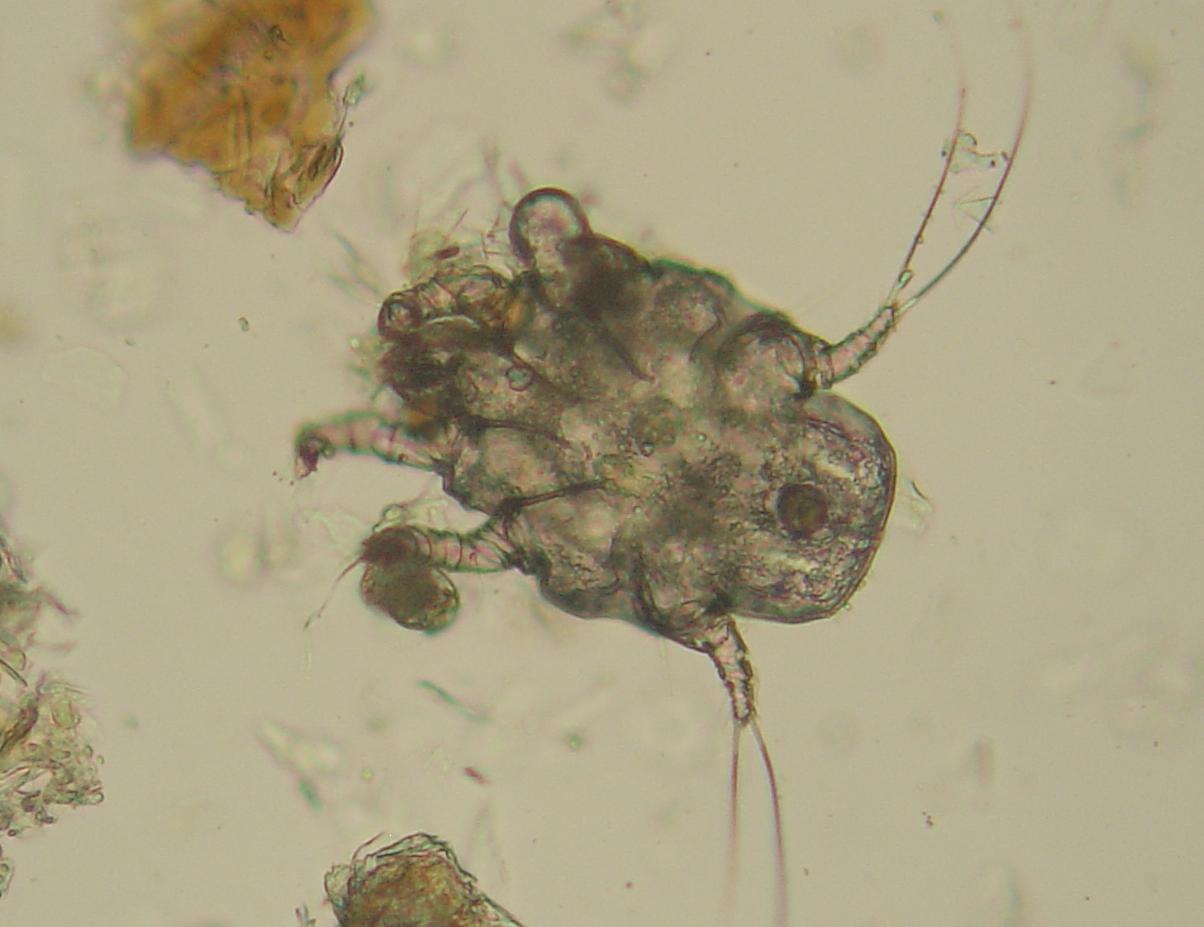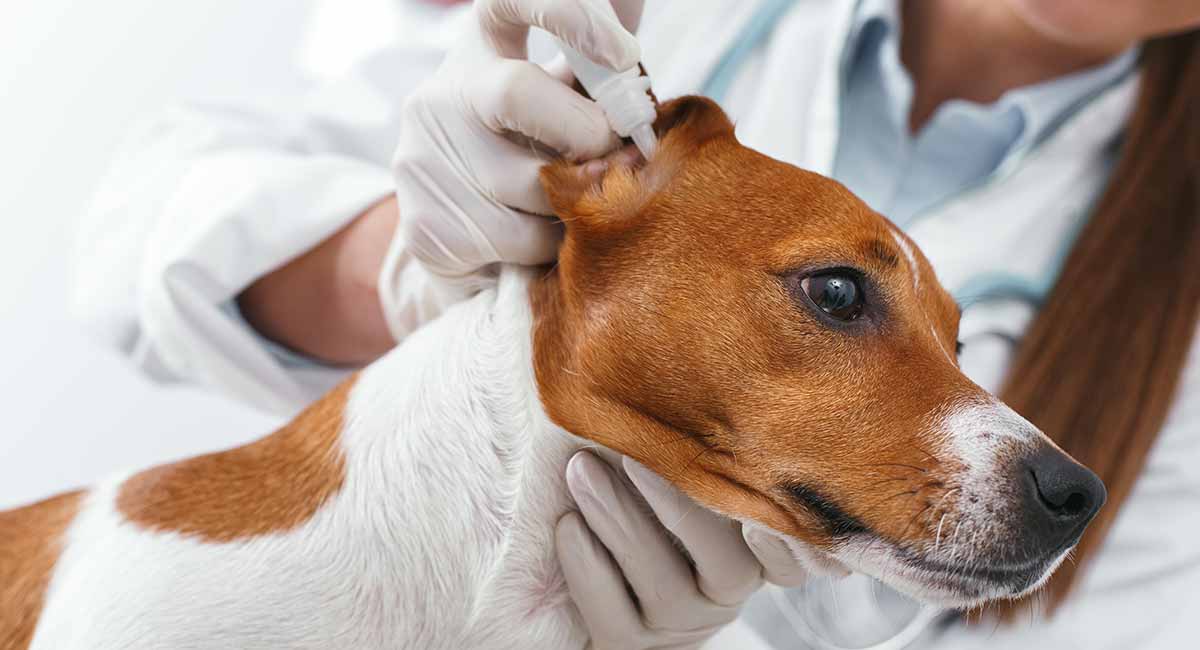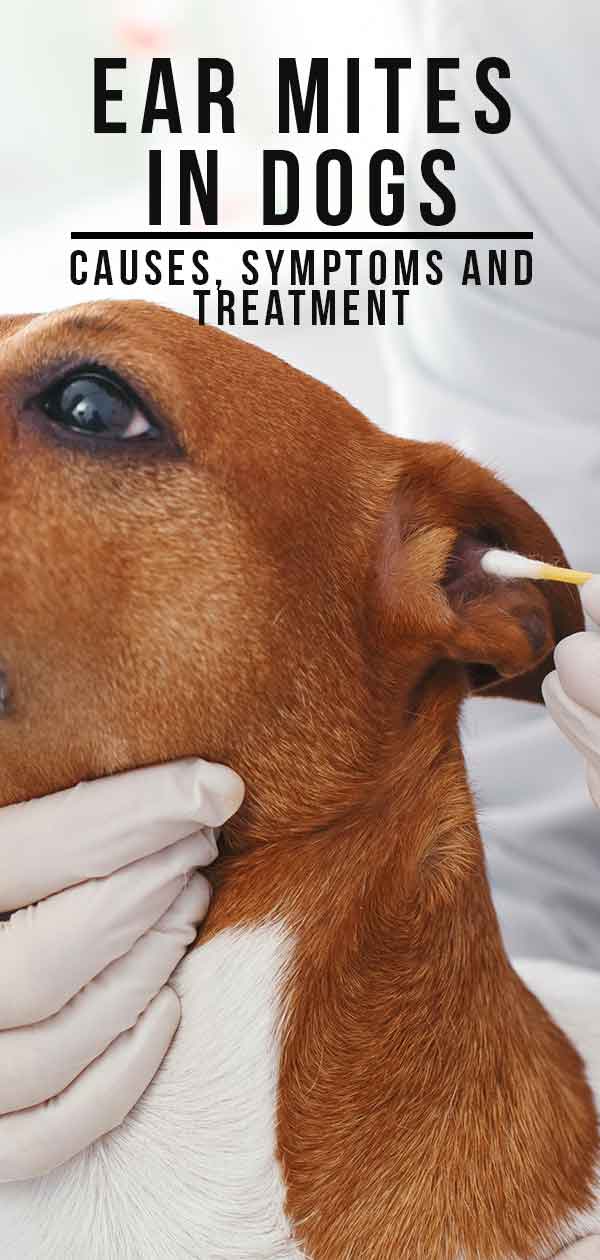Ear mites in dogs are a common problem. Discover the symptoms and treatment options including whether home remedies can get rid of dog ear mites.
We explain what ear mites are and answer your question “How do dogs get ear mites?”.
We help you to recognize the signs that your dog might have ear mites and discuss when you need to get to your vet for help.
Ear mite treatment for dogs is explained. We look at the various options and also how to get rid of ear mites in dogs permanently.
So, let’s find out first what exactly these pesky mites are.
What are ear mites in dogs
Ear mites are tiny spider-like parasites that like to live inside a dog’s ear canal. In medical terms the condition is known as otodectic mange.
Up to half of ear infections in dogs are caused by ear mites. However, it’s important to realise that all ear infection symptoms are very similar.
The species of mite that most commonly affects dogs is called Otodectes Cynotis. These parasites prefer to live in a dark, moist and warm environment. Obviously, this makes your pup’s ears a perfect place for them to set up home.
Ear mites don’t burrow under the skin but live on the dead skin cells and wax that gathers in your dog’s ears. They can prick and scratch the skin though, which causes irritation and inflammation.
The ear mite life cycle
The adult mite lays her eggs in your dog’s ear canal and after a few days a larva hatches from each egg. These larvae then go through two nymphal stages, each lasting just a few days, before becoming adults ready to breed.
The whole cycle takes less than a month. Over quite a short space of time, a significant colony of mites can develop – all breeding and laying more eggs inside your dog’s ears.
In serious cases, the colony can even spill out and spread across your dog’s head and face.
Ear mites do crawl around and so are sometimes found on other parts of a dog’s body. After their head, the top of the tail is the most common because many dogs sleep curled up.

How do dogs get ear mites?
Ear mites are very contagious and spread easily to other pets – especially when they play and sleep together. The mites crawl around in your dog’s fur, and they’ll climb across from one animal to another.
So any dog that has physical contact with another pet who has ear mites, could be at risk of developing an ear mite problem. Ear mites can also survive for weeks to months without a host animal.
How to recognize ear mites in dogs
Because they’re so small, ear mites in dogs are quite difficult to see with the naked eye. You might spot them as tiny white dots if you clear out some of the debris from your pup’s ear.
Your vet can usually spot the mites when he looks into your dog’s ears with an otoscope – an instrument that both lights up and magnifies the inside of the ear.
The presence of ear mites can also be confirmed by taking a sample of wax from the dog’s ear and looking at it under a microscope.
Ear mites usually give us clues to their presence because of the way they affect your dog, causing symptoms and behavior changes.
Symptoms of ear mites in dogs
Not all dogs with ear mites will show symptoms – especially in the beginning. Many pet owners only discover that their dog has ear mites when they take them to the vet to find out why they’re rubbing their ears.
Your dog may scratch or rub their ears, or rub the sides of their faces along the ground. Head shaking so that their ears flap is another sign of ear mites in dogs.
When a dog has ear mites, the ear wax usually becomes dark and grubby – described as looking like coffee grounds. The wax could be more profuse than normal and also have a foul smell.
You might also notice that your dog’s ears are red and inflamed. Rashes or other skin disorders can develop on the skin around the ears. This happens especially in those dogs that have a hypersensitive reaction to ear mites.
You must however realise that the signs shown by dogs with ear mites can also be symptoms of other conditions. Vets report often seeing dogs with bacterial or fungal ear infections whose owners had been treating them at home for ear mites for weeks or months.
So don’t just assume that it’s ear mites that are causing the problem – get a proper diagnosis from your vet.
You may have heard that only some dog breeds get ear mites.
Ear mites – Dogs that are most susceptible
Because ear mites in dogs thrive in warmth and darkness, some dogs are more likely to have problems with them than others.
A dog with pricked up ears, like a German Shepherd for example, has a cooler, dryer ear canal than a dog with floppy ears.
Ear flaps trap warm moist air inside the ear canal. So dogs like Labradors and Cocker Spaniels, with ear flaps that cover their ear canals, are more susceptible to ear mite problems
Now you may be wondering whether other pets also get to ear mites.
Can dogs give ear mites to cats?
Yes, your dog can pass ear mites on to other pets. Including your cat.
In fact, ear mites occur more commonly in cats than in dogs so there’s a good chance that your cat passed them on to your dog.
Rabbits, ferrets and other small animals can be infected too.
Can dogs give ear mites to people
In theory, dog ear mites can survive in a human ear – and there is an example of a vet who deliberately infected herself with ear mites for research purposes.
In practice – it’s pretty much unheard of for anyone to catch ear mites from their pet.
Sensible precautions, such as washing your hands after treating your dog’s ears, should be sufficient to protect you.
Why dog ear mites need treating
Ear mite treatment for dogs, and curing the problem, is very necessary.
Not only are ear mites distressingly itchy and painful for your pet, but leaving them untreated can cause serious problems.
The constant scratching can cause open wounds in and around your dog’s ears that could then become infected with bacteria or fungi. The irritation and inflammation can also cause thickening of the skin and permanently damage their ears.
Your dog’s ears can become blocked, they could lose their balance and, if left untreated, the condition can eventually cause deafness.
Another serious consequence can be an aural hematoma. The ear-flapping, head shaking can lead to a burst blood vessel with a large bubble of blood forming inside the ear flap itself. This can break open, with dramatic results, and can be very troublesome to heal.
Your first port of call if your dog is showing signs of an ear problem is to get your dog down to the vet.
Diagnosing ear mites in dogs
Your vet will first examine your dog’s ears by looking inside them with an otoscope.
If your dog’s ears are already very painful, or the inside of their ears very swollen, sedation may be necessary for a proper examination.
Your vet will probably also do a microscopic examination – even if they can actually spot the mites inside your dog’s ears. Some of the wax and debris is collected and viewed under a microscope.
This way your vet will be able to discover how many mites there are – in other words how serious the infestation is. They’ll also be able to see if there are other bacterial or fungal infections present.
Before any treatment can be started your dog’s ears will need to be cleaned out. The built-up wax and other debris will prevent any medication from reaching the area where it has to work.
Your vet will probably do the initial cleaning. They might first use a formulation that softens the waxy build-up before flushing out the ears. They might also provide you with a solution and instructions to keep your dog’s ears clean at home.
Once the diagnosis is made, and your dog’s ear are clean, your vet will decide on treatment.
Ear mite treatment for dogs
Ear mites can be killed with a number of different drugs. Your vet will prescribe one or more of these for you, depending on how serious the infestation is.
Some of the newer medications against parasites, like Frontline Spot-on, are used most often these days. They are long lasting and you don’t have to put your pup through the routine of putting medicine in their ears every day for weeks as in the past.
Vets usually also prescribe whole body treatment with one of the long-lasting medicines against parasites to kill any mites that may have moved out onto the body.
By keeping up with these treatments monthly, or as recommended, you can prevent all future ear mite infestation – as well as ticks, fleas and other parasites.
Your vet might also prescribe medicine to relieve your pup’s distressing itching, skin irritation and pain until the condition is under control. Your dog might also need antibiotics, usually ear drops, if they have a bacterial or fungal infection as well.
Because ear mites are passed on between pets your vet will probably recommend that you treat them all, even the ones that don’t have any symptoms.
- Hypoallergenic Dogs: The Facts About Non-Shedding
Home remedies for ear mites in dogs
Because ear mites in dogs are such a common problem many home remedies have been used and passed on over the years. There are over-the-counter ear mite treatments for dogs or maybe you prefer natural treatments rather than drugs.
Some of these treatments do work but there are a few very important points that you should keep in mind:
- You need to be very sure that mites are the cause of your dog’s ear problem – you should get a definite diagnosis from your vet. Don’t waste your time and money using on a wrong treatment while your pet’s condition just gets worse.
- Home remedies should never be used if your dog already has sores in his ears or a burst eardrum. Another reason to first consult your vet.
- Both over the counter and home remedies kill only adult mites. They must be applied daily, or as prescribed, for at least a month – remember that the cycle from egg to adult is around three weeks. Never stop the recommended treatment because your dog’s ears seem better.
- Before starting any treatment, you must clear out the built-up wax and debris from your dog’s ears.
Cleaning your dog’s ears
This link provides guidance on how to clean your puppy’s ears.
Never try and clean deep into your dog’s ear canal with an ear bud. This could be very painful if your pup’s ears are already inflamed and you also risk perforating his eardrum.
Also avoid pointing applicators or syringes directly into the ear canal. If your dog moves suddenly this could also cause a perforated eardrum.
Vinegar, apple cider vinegar and hydrogen peroxide are often recommended as ear mite treatment for dogs. However, these solutions don’t kill ear mites. They’re only useful for cleaning your dog’s ears and possibly relieving some of the itch.
They must always be diluted and only used on a swab to gently wipe out the inside of your dog’s ears. Flushing your dog’s ears with these harsh chemicals can damage the sensitive skin inside the ear and cause infections.
A green tea infusion or witch hazel are alternative and gentler solutions for cleaning your dog’s ears.
Oil treatments for ear mites in dogs
The home remedy that does kill ear mites in dogs are those where you insert oil into your pup’s ears with a dropper. You might find recommendations for a number of different oils – olive oil, baby oil, mineral oil, oregon grape oil.
They all work in the same way – they smother the adult mites. You need to continue with daily treatments for at least a month.
You might also come across suggestions for various herbs that can be added to the oil. Some have soothing properties to help relieve the itch. Others like garlic and honey have mild antibiotic properties.
If you do decide on a home treatment, take your pup to the vet if you don’t see any improvement within a few days. Also if there is any bleeding. There may be another problem besides ear mites and you don’t want to take a chance with your pet’s future health.
Your next question is probably how to get rid of ear mites in dogs permanently.
Preventing ear mites in dogs
When your dog has picked up ear mites the first step you need to take is to treat all your other pets, whether they have symptoms or not.
The next step is to rid the environment of any ear mites and their eggs. Wash your pets’ bedding, and other items like toys, in hot water. Allow them dry very well in the sun or in a hot dryer. Vacuum the areas where your pets spend most of their time.
Furthermore, be sure to keep your dog’s ears clean and check them regularly for any signs of a new infection.
You can also clip the hair on the inside of your dog’s ear flap and around the opening to their ear canal. This helps to keep the ear ventilated and dry.
The best way to keep your pets free from ear mites permanently is through regular parasite control treatment which you can get from your vet.
Ear mites in dogs – a summary
Ear mites are annoying parasites that if left untreated can cause pain, distress and eventually hearing loss.
Typical symptoms are
- Scratching ears
- Rubbing ears
- Flapping ears
- Head shaking
- Brown gunky wax in the ear canal
Ear mites aren’t usually an out of hours emergency, but as soon as the vet’s office opens, get your dog down there and let them take a look.
Don’t wait until your dog is so sore that he needs to be sedated to have his ears examined
Veterinary treatment can be costly. However, treating an infected wound or ear flap haematoma, will cost you more than simply treating the original infection at an early stage.
Keeping your dog free from ear mites will prevent injuries, protect his hearing and spare him the distress and pain caused by these troublesome parasites.
This article has been extensively revised and updated for 2019.
References
- CAPC. Pets and parasites – ear mites. Companion Animal Parasite Council.
- Combarros, D. 2019. Comparison of three methods for the diagnosis of otoacariasis due to Otodectes cynotis in dogs and cats. Veterinary Dermatology.
- Curtis C F. 2004 Current trends in the treatment of Sarcoptes, Cheyletiella and Otodectes mite infestations in dogs and cats. Veterinary Dermatology.
- Moriello, K.A. Overview of otitis externa. MSD Veterinary Manual.
- Norulhuda W. 2017 A survey of ear mites (Otodectes cynotis) in stray cats in Kota Bharu, Kelantan, West Malaysia. Malaysian Journal of Veterinary Research.
- Richards, M. Ear mites in dogs. Vetinfo.
- Vetinfo. Home remedies for ear mites in dogs. Vetinfo






Leave a Reply